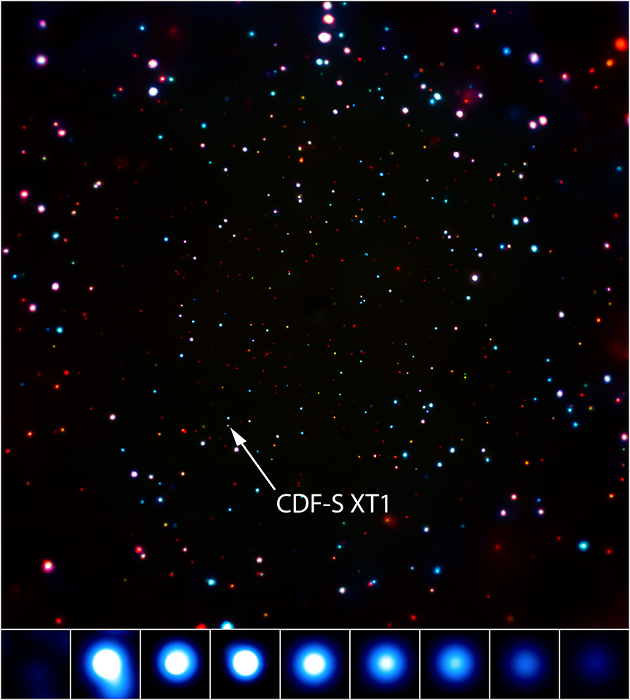
 Credit: X-ray: NASA/CXC/Universidad Cat´olica de Chile/F.Bauer et al.
Credit: X-ray: NASA/CXC/Universidad Cat´olica de Chile/F.Bauer et al.
Mysterious Flash in the Deep Field
The X-ray sky is known for its sudden variability. That's because X-ray emission is often produced by powerful, usually unstable processes - magnetic-powered flares, thermonuclear explosions on the surface of compact stars, black holes ripping stars apart with their intense gravity, and other explosive, violent phenomena. A whole host of X-ray variable sources have been observed and characterized by high-energy astrophysicists. So it's strange to see a new variable X-ray source that does not fit into one of the known categories. In a long pointed observation with the Chandra X-ray Observatory at a patch of sky known as the Deep Field South, astronomers have recently seen such a mysterious event. For this Deep Field South observation (shown above in a false-color image in which red represents low-energy X-rays and blue high-energy X-rays), Chandra stared at a single patch of sky for a time equivalent to about 85 days. In the last portion of this observation, astronomers noticed a sudden bright flash of X-rays from a previously invisible source (which is marked CDF-S XT1 in the image above). This source suddenly flared into prominence, and stayed bright for a fraction of a day before eventually fading away (as shown by the series of images of the source at the bottom of the graphic). The way in which the source suddenly flared and faded, along with the variation of the energy distribution of source's X-rays, puzzled the discoverers, since the changes did not seem to fit with any known type of X-ray variable. They suggested that CDF-S XT1 might be some type of exotic phenomena: perhaps a strange exploding star producing a supernova or gamma-ray burst in a distant galaxy; or a black hole swallowing a star; or perhaps a superpowerful burst from a small star in the Milky Way. None of these explanations are entirely satisfactory, however. It may be that this source marks the discovery of an entirely new phenomena, perhaps similar to the mysterious fast bursts discovered recently by radio astronomers. Will this source re-appear? Are there more such sources in other galaxies, or in our own? Let the hunt begin.
Published: April 3, 2017
<
HEA Dictionary ● Archive
● Search HEAPOW
● Other Languages
● HEAPOW on Facebook
● Download all Images
● Education ● HEAD
>

Each week the HEASARC
brings you new, exciting and beautiful images from X-ray and Gamma ray
astronomy. Check back each week and be sure to check out the HEAPOW archive!
Page Author: Dr. Michael F. Corcoran
Last modified Tuesday, 27-Feb-2024 10:15:23 EST


